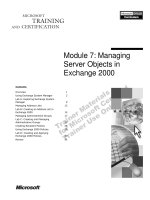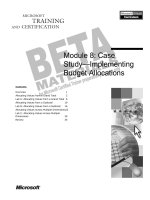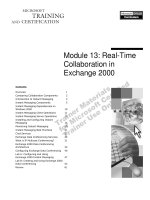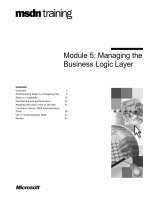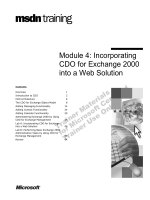Tài liệu Module 13: Real-Time Collaboration in Exchange 2000 pptx
Bạn đang xem bản rút gọn của tài liệu. Xem và tải ngay bản đầy đủ của tài liệu tại đây (2.27 MB, 68 trang )
&RQWHQWV##
2YHUYLHZ#4#
&RPSDULQJ#&ROODERUDWLRQ#&RPSRQHQWV#5#
,QWURGXFWLRQ#WR#,QVWDQW#0HVVDJLQJ#6#
,QVWDQW#0HVVDJLQJ#&RPSRQHQWV#8#
,QVWDQW#0HVVDJLQJ#'HSHQGHQFLHV#RQ#
:LQGRZV#5333# 43#
,QVWDQW#0HVVDJLQJ#&OLHQW#2SHUDWLRQV# 44#
,QVWDQW#0HVVDJLQJ#6HUYHU#2SHUDWLRQV# 46#
,QVWDOOLQJ#DQG#&RQILJXULQJ#,QVWDQW##
0HVVDJLQJ# 47#
0RQLWRULQJ#,QVWDQW#0HVVDJLQJ# 53#
,QVWDQW#0HVVDJLQJ#%HVW#3UDFWLFHV# 54#
&KDW#6HUYLFHV# 55#
([FKDQJH#'DWD#&RQIHUHQFLQJ#6HUYLFHV# 57#
:KDW#LV#,3#0XOWLFDVW#&RQIHUHQFLQJ"# 64#
([FKDQJH#5333#'DWD#&RQIHUHQFLQJ#
$UFKLWHFWXUH# 66#
&RQILJXULQJ#([FKDQJH#'DWD#&RQIHUHQFLQJ## 73#
/DE#$=#&RQILJXULQJ#DQG#8VLQJ##
([FKDQJH#5333#,QVWDQW#0HVVDJLQJ# 7:#
/DE#%=#&UHDWLQJ#DQG#8VLQJ#([FKDQJH#5333#
'DWD#&RQIHUHQFLQJ# 86#
5HYLHZ## 94#
#
Module 13: Real-Time
Collaboration in
Exchange 2000
Information in this document is subject to change without notice. The names of companies,
products, people, characters, and/or data mentioned herein are fictitious and are in no way intended
to represent any real individual, company, product, or event, unless otherwise noted. Complying
with all applicable copyright laws is the responsibility of the user. No part of this document may
be reproduced or transmitted in any form or by any means, electronic or mechanical, for any
purpose, without the express written permission of Microsoft Corporation. If, however, your only
means of access is electronic, permission to print one copy is hereby granted.
Microsoft may have patents, patent applications, trademarks, copyrights, or other intellectual
property rights covering subject matter in this document. Except as expressly provided in any
written license agreement from Microsoft, the furnishing of this document does not give you any
license to these patents, trademarks, copyrights, or other intellectual property.
2000 Microsoft Corporation. All rights reserved.
Microsoft, MS-DOS, MS, Windows, Windows NT, Active Directory directory service, ActiveX,
BackOffice, FrontPage, Hotmail, MSN, Outlook, PowerPoint, SQL Server, Visual Studios, and
Win32, are either registered trademarks or trademarks of Microsoft Corporation in the U.S.A.
and/or other countries.
The names of companies, products, people, characters, and/or data mentioned herein are fictitious
and are in no way intended to represent any real individual, company, product, or event, unless
otherwise noted.
Other product and company names mentioned herein may be the trademarks of their respective
owners.
Project Lead:
David Phillips
Instructional Designers:
Lance Morrison (Wasser), Janet Sheperdigian, Steve Thues
Lead Program Manager:
Mark Adcock
Program Manager:
Lyle Curry, Scott Hay, Janice Howd, Steve Schwartz (Implement.Com),
Bill Wade (Wadeware LLC)
Graphic Artist:
Kimberly Jackson, Andrea Heuston (Artitudes Layout and Design)
Editing Manager:
Lynette Skinner
Editor:
Elizabeth Reese (Write Stuff)
Copy Editor:
Ed Casper (S&T Consulting), Carolyn Emory (S&T Consulting), Patricia Neff
(S&T Consulting), Noelle Robertson (S&T Consulting)
Online Program Manager:
Debbi Conger
Online Publications Manager:
Arlo Emerson (Aquent Partners)
Online Support:
Eric Brandt
Multimedia Developer
: Kelly Renner (Entex)
Compact Disc Testing:
Data Dimensions, Inc.
Production Support:
Ed Casper (S&T Consulting)
Manufacturing Manager:
Bo Galford
Manufacturing Support:
Rick Terek
Lead Product Manager, Development Services:
Lead Product Manager:
David Bramble
Group Product Manager:
Robert Stewart
# 0RGXOH#46=#5HDO07LPH#&ROODERUDWLRQ#LQ#([FKDQJH#5333# # LLL#
,QVWUXFWRU#1RWHV##
This module provides students with the information necessary to differentiate
between the three different real-time collaboration solutions, choose which has
the best functions for a particular purpose, and gain the experience needed to
install and use real-time collaboration.
At the end of this module, students will be able to:
„#
Describe the advantages and limitations of each of the three real-time
collaboration solutions.
„#
Describe the Instant Messaging components.
„#
Install and configure Instant Messaging.
„#
Describe the functions of the Chat Services.
„#
Describe the features and components of Microsoft
®
Exchange 2000 Data
Conferencing Services.
„#
Explain the differences between conferencing under Microsoft Exchange
Server version 5.5 and under Exchange 2000.
„#
Describe the Data Conferencing architecture.
„#
Describe the ways Data Conferencing is dependent upon Exchange 2000.
„#
Configure Data Conferencing.
„#
Use System Monitor to monitor Data Conferencing.
3UHVHQWDWLRQ=##
93#0LQXWHV#
#
/DEV=#
78#0LQXWHV#
LY##0RGXOH#46=#5HDO07LPH#&ROODERUDWLRQ#LQ#([FKDQJH#5333#
0DWHULDOV#DQG#3UHSDUDWLRQ#
This section provides you with the required materials and preparation tasks that
are needed to teach this module.
5HTXLUHG#0DWHULDOV#
To teach this module, you need the following materials:
•
Microsoft PowerPoint
®
file 1569A_13.ppt
3UHSDUDWLRQ#7DVNV##
To prepare for this module, you should:
„#
Read all the materials for this module.
„#
Complete the labs.
,QVWUXFWRU#6HWXS#IRU#D#/DE#
This section provides setup instructions that are required to prepare the
instructor computer or classroom configuration for a lab.
/DE#%=#&UHDWLQJ#DQG#8VLQJ#([FKDQJH#5333#'DWD#
&RQIHUHQFLQJ#6HUYLFHV#
This lab is optional. To perform this lab, students need cameras and headsets
for their computers.
# 0RGXOH#46=#5HDO07LPH#&ROODERUDWLRQ#LQ#([FKDQJH#5333# # Y#
0RGXOH#6WUDWHJ\#
Use the following strategy to present this module:
„#
Comparing Collaboration Components
The module starts with an overview of the three real-time collaboration
components. The comparison slide is a good place to describe the different
purposes of each component.
„#
Instant Messaging Components
This section describes the overall architecture of Instant Messaging and then
goes into greater detail about the server and client, and their relationship to
Windows 2000. The important points are the improvements in the
architecture over the design of Exchange Server 5.5.
„#
Configuring Instant Messaging
This topic describes the features that need to be configured and how to do it.
„#
Monitoring Instant Messaging
This topic describes important considerations for administrators to monitor
to ensure optimum performance. It discusses only tools that have already
been introduced.
„#
Instant Messaging Best Practices
This is a list of the best practices for configuring Instant Messaging at the
time the course was written. Bear in mind that the product was still in beta
so these practices may change with the released version.
„#
Chat Services
There is only one slide about this topic. It is not considered a major feature,
and you can cover it quickly.
„#
Introduction to Exchange Data Conferencing
This topic describes the various features of data conferencing. The
comparison between conferencing under Exchange Server 5.5 and
Exchange 2000 are the most important points of the section.
„#
Exchange 2000 Data Conferencing Architecture
The important point to emphasize in the architecture section is the
dependence of data conferencing on services provided by Windows 2000.
„#
Configuring Exchange Data Conferencing
This topic describes the tools used to configure data conferencing and how
to do it.
YL##0RGXOH#46=#5HDO07LPH#&ROODERUDWLRQ#LQ#([FKDQJH#5333#
„#
Lab A: Configuring and Using Instant Messaging
This is a short, fun lab in which the students can send messages to each
other. If you want to break up the long lecture, this lab can easily be
performed at the end of the Instant Messaging topic.
„#
Lab B: Creating and Using Exchange 2000 Data Conferencing
This lab is at the end because it is optional and you can expect some
students to leave early. This way, they will hear the lecture even if they miss
the lab. The students who perform it usually enjoy setting up and using their
cameras to communicate with each other through NetMeeting. Even if they
do not have cameras, students can configure their servers and collaborate
using application sharing based on the last exercise in the lab.
# 0RGXOH#46=#5HDO07LPH#&ROODERUDWLRQ#LQ#([FKDQJH#5333# # 4#
2YHUYLHZ#
„
&RPSDULQJ#&ROODERUDWLRQ#&RPSRQHQWV
„
0LFURVRIW#([FKDQJH#,QVWDQW#0HVVDJLQJ#6HUYLFHV
„
0LFURVRIW#([FKDQJH#&KDW#6HUYLFHV
„
0LFURVRIW#([FKDQJH#'DWD#&RQIHUHQFLQJ#6HUYLFHV
Traditional e-mail systems cannot transfer dynamic data and information on
demand. For these functions, users still rely on the telephone. Real-time
collaboration services in Microsoft Exchange 2000 provide the immediacy of
the telephone with the functionality of e-mail.
&RPSDULQJ#&ROODERUDWLRQ#&RPSRQHQWV#
The different collaboration services are designed for specific types of
collaboration.
,QVWDQW#0HVVDJLQJ#6HUYLFHV#
Instant Messaging is designed for individual users to have one-to-one
conversations.
&KDW#6HUYLFHV#
Deploy Chat Services in scenarios where individuals need to communicate in
groups, such as in a discussion forum.
'DWD#&RQIHUHQFLQJ#6HUYLFHV#
Data Conferencing Services enable you to pre-arrange an electronic conference.
Participants can share multimedia information, and chat with each other.
At the end of this module, you will be able to:
„#
Choose the appropriate collaboration component to use for a given situation.
„#
Describe the function and configuration of Instant Messaging Services.
„#
Describe the function and configuration of Chat Services.
„#
Describe the function and configuration of Data Conferencing Services.
6OLGH#2EMHFWLYH#
7R#SURYLGH#DQ#RYHUYLHZ#RI#
WKH#PRGXOH#WRSLFV#DQG#
REMHFWLYHV1#
/HDG0LQ#
,Q#WKLV#PRGXOH/#\RX#ZLOO#VHH#
KRZ#([FKDQJH#5333#KDV#
EHFRPH#PRUH#WKDQ#MXVW#DQ#
H0PDLO#VHUYHU1##
5# # 0RGXOH#46=#5HDO07LPH#&ROODERUDWLRQ#LQ#([FKDQJH#5333#
&RPSDULQJ#&ROODERUDWLRQ#&RPSRQHQWV#
Use/Design
Use/Design
Use/Design
Instant
Messaging
Instant
Instant
Messaging
Messaging
Chat Server
Chat Server
Chat Server
Data
Conferencing
Data
Data
Conferencing
Conferencing
Primary Use
Primary Use
Instant
Messaging
Instant
Messaging
Chat Server
Chat Server
Data
Conferencing
Data
Conferencing
Meeting Style
Meeting Style
Closed
Closed
Open Forum
Open Forum
Invitation Only
Invitation Only
Meeting
Structure
Meeting
Structure
Immediate/Ad-
Hoc
Immediate/Ad-
Hoc
Ad-Hoc/Semi
Structured
Ad-Hoc/Semi
Structured
Organized
Organized
Client Type
Client Type
Vendor-Specific
Vendor-Specific
Standards-Based
Standards-Based
T.120 Standards
T.120 Standards
Client
Facilities
Client
Facilities
Basic
Basic
Basic
Basic
Advanced
Advanced
Primary
Deployment
Primary
Deployment
Corporate
Corporate
Service Provider
Service Provider
Corporate
Corporate
Instant Messaging, Chat, and Data Conference all have unique features suited to
different, specific situations.
6OLGH#2EMHFWLYH#
7R#EULHIO\#FRPSDUH#WKH#
LQWHQGHG#XVHV#RI#WKH#WKUHH#
FROODERUDWLRQ#IHDWXUHV#LQ#
([FKDQJH#53331#
/HDG0LQ#
(DFK#RI#WKH#WKUHH#
FROODERUDWLRQ#FRPSRQHQWV#LQ#
([FKDQJH#5333#LV#GHVLJQHG#
IRU#D#VSHFLILF#W\SH#RI#
FRPPXQLFDWLRQ1#
# 0RGXOH#46=#5HDO07LPH#&ROODERUDWLRQ#LQ#([FKDQJH#5333# # 6#
,QWURGXFWLRQ#WR#,QVWDQW#0HVVDJLQJ#
Exchange Instant Messenger
File Tools Help
Add Send
Contacts Currently Online
sakhtar@im-2k (Online)
dcampbell@im-2k (Online)
sgode@im-2k (Online)
Contacts Not Online
seanch@im-2k (Offline)
kbowen@im-2k (Offline)
scottfal@im-2k (Offline)
linleste@im-2k (Offline)
amyjon@im-2k (Offline)
kjordan@im-2k (Offline)
Online
Instant messaging allows you to send messages that require an immediate
response from the receiver. You can also see when other people are online, out
of the office, or not receiving calls (this is called presence information). For
example, members of a virtual team that are collaborating with one another to
produce a single product may need the urgency of information delivered by
Instant Messaging; or in the Internet space, friends may want to chat with one
another through a live discussion thread, without the overhead of composing
and sending e-mail.
The major difference between e-mail and instant messages is that instant
messages are not kept in the Exchange 2000 store; after a message has
disappeared from the screen, it is gone forever.
The Instant Messaging client is an iteration of the Microsoft MSN
™
Messenger
product. You can start the client automatically as soon as you log on and keep it
open in the corner of your screen all day.
When you are online, this fact is sent as a status notification to the Instant
Messaging server that passes the information to other members of the team or
interested parties. Likewise, a user logging on to the network can quickly find
out who else is online and able to communicate.
Instant Messaging is designed as a way to track the presence of each member of
an individual team. For example, as an Instant Messaging user, you may have
listed in your client ten other team members, their manager, three contacts in
other companies, and a few friends on the Internet.
6OLGH#2EMHFWLYH#
7R#LQWURGXFH#WKH#FRQFHSW#RI#
LQVWDQW#PHVVDJLQJ1#
/HDG0LQ#
$V#WKH#QDPH#LPSOLHV/#,QVWDQW#
0HVVDJLQJ#LV#XVHG#WR#
FRPPXQLFDWH#LQWHUDFWLYHO\#
ZLWK#DQRWKHU#SHUVRQ#
LQVWDQWO\1#
7# # 0RGXOH#46=#5HDO07LPH#&ROODERUDWLRQ#LQ#([FKDQJH#5333#
There are seven modifiable presence settings that you can change as appropriate
on your Instant Messaging client:
„#
Online
„#
Invisible (this prevents your presence information from being displayed
even though you are at your computer)
„#
Busy
„#
Be Right Back
„#
Away From Computer
„#
On the Phone
„#
Out to Lunch
There are two automatic presence settings that can be used by your Instant
Messaging client:
„#
Idle. When there has been no activity at your keyboard for a given time, the
screen saver trigger is activated and your status is set to idle. It switches
back to online when you touch a key.
„#
Offline. You are not logged on to the Instant Messaging server.
,QVWDQW#0HVVDJLQJ#'RPDLQ#
An Instant Messaging domain is a logical collection of Instant Messaging users
and servers represented by a virtual server called an Instant Messaging router.
Instant Messaging routers can have Domain Name System (DNS) hostnames
that are visible to external (Internet) users.
,QVWDQW#0HVVDJLQJ#+RPH#6HUYHU#
Each Instant Messaging domain must contain at least one home server, which is
a virtual server that hosts Instant Messaging user accounts. Home servers also
store status information for users assigned to that particular server.
,QVWDQW#0HVVDJLQJ#5RXWHU#
An Instant Messaging router receives instant messages, determines their
destination home server, and forwards the messages to user accounts on the
home server. Because the Instant Messaging domain name represents the host
name of the router, users do not need to know the individual home server names
because the router obtains the server names from Active Directory, and routes
users accordingly.
,QVWDQW#0HVVDJLQJ#7UDQVSRUW#DQG#0HVVDJH#)RUPDW#
All Instant Messaging communication takes place over HTTP (Hypertext
Transfer Protocol). The message format is XML (Extensible Markup
Language).
# 0RGXOH#46=#5HDO07LPH#&ROODERUDWLRQ#LQ#([FKDQJH#5333# # 8#
‹‹
#,QVWDQW#0HVVDJLQJ#&RPSRQHQWV#
Server
Admin.
(MMC)
Server
Admin.
(MMC)
Server
Application
Layer
Server
Application
Layer
FTM
FTM
Locator
Locator
Node
Database
Messenger
Client UI
Messenger
Client UI
RVP
RVP
MSN
MSN
AOL
AOL
Active
Directory
Active
Directory
Internet
Information
Services
Internet
Information
Services
DNS
DNS
The Instant Messaging architecture includes components located both at the
client and the server. The Instant Messaging Server and Client also rely on
Windows 2000 to provide services, such as Domain Name System (DNS) and
Security.
6OLGH#2EMHFWLYH#
7R#LQWURGXFH#WKH#VWUXFWXUDO#
FRPSRQHQWV#RI#,QVWDQW#
0HVVDJLQJ1#
/HDG0LQ#
,QVWDQW#0HVVDJLQJ#XVHV#
FRPSRQHQWV#RQ#ERWK#WKH#
VHUYHU#DQG#WKH#FOLHQW#VLGH#RI#
WKH#WUDQVDFWLRQ1#
9# # 0RGXOH#46=#5HDO07LPH#&ROODERUDWLRQ#LQ#([FKDQJH#5333#
,QVWDQW#0HVVDJLQJ#6HUYHU#&RPSRQHQWV#
Server
Admin.
(MMC)
Server
Admin.
(MMC)
Server
Application
Layer
Server
Application
Layer
FTM
FTM
Locator
Locator
Node
Database
Messenger
Client UI
Messenger
Client UI
RVP
RVP
MSN
MSN
AOL
AOL
Active
Directory
Active
Directory
Internet
Information
Services
Internet
Information
Services
DNS
DNS
The Instant Messaging server itself runs as part of the Windows 2000 Internet
Information Services (IIS) process (Inetinfo.exe) and is implemented as an
Isapi.dll.
6HUYHU#$SSOLFDWLRQ#/D\HU#
The server application layer does the majority of the work and communicates
with other server-side Instant Messaging components and Active Directory
™
directory service.
5HQGH]YRXV#3URWRFRO#
All Instant Messaging communication between clients and servers takes place
by using the RVP protocol (also known as the rendezvous protocol). RVP is an
extended subset of Hypertext Transfer Protocol - Distributed Authoring and
Versioning (HTTP-DAV), which is an extension to HTTP 1.1.
Developers can use RVP within their applications to access the Instant
Messaging presence data for other uses.
1RGH#'DWDEDVH#
The Node Database is an instance of the Extensible Storage Engine (ESE) that
retains status information for Instant Messaging users.
6OLGH#2EMHFWLYH#
7R#H[SODLQ#WKH#SDUWV#RI#
,QVWDQW#PHVVDJLQJ#WKDW#
UHVLGH#RQ#D#VHUYHU1#
/HDG0LQ#
7KH#,QVWDQW#0HVVDJLQJ#
VHUYHU#LV#FRPSRVHG#RI#ILYH#
PDMRU#FRPSRQHQWV1#
# 0RGXOH#46=#5HDO07LPH#&ROODERUDWLRQ#LQ#([FKDQJH#5333# # :#
)LUHZDOO#7RSRORJ\#0RGXOH#
You can choose whether to enable Instant Messaging with entities outside of
the corporate network, such as other Exchange 2000 installations maintained by
business partners, suppliers, or customers. Some organizations may need
intranet-only messaging. In these cases, all of the Instant Messaging
infrastructure is located behind the firewall, and is never exposed to the
Internet. If your company needs connectivity with the Internet, you should
protect your internal Instant Messaging network with firewalls in both the
inbound and outbound directions.
The Firewall Topology Module (FTM) retains information about each Instant
Messaging Server, whether it is inside or outside of the firewall. It also
maintains information about how to get through the firewall. The FTM contains
data that tells whether a given source Internet Protocol (IP) can connect to a
given destination IP, and whether a proxy server is required.
/RFDWRU##
The locator dispatches notifications to the correct home server when the
messages are passed through the bridgehead servers.
;# # 0RGXOH#46=#5HDO07LPH#&ROODERUDWLRQ#LQ#([FKDQJH#5333#
,QVWDQW#0HVVDJLQJ#&OLHQW#&RPSRQHQWV#
Server
Admin.
(MMC)
Server
Admin.
(MMC)
Server
Application
Layer
Server
Application
Layer
FTM
FTM
Locator
Locator
Node
Database
Messenger
Client UI
Messenger
Client UI
RVP
RVP
MSN
MSN
AOL
AOL
Active
Directory
Active
Directory
Internet
Information
Services
Internet
Information
Services
DNS
DNS
You use the Instant Messaging Client to log on to the Instant Messaging server,
and communicate with other Instant Messaging users. It includes the following
components:
„#
Instant Messaging Client User Interface (UI)
Users can use the IM Client to log on to an Instant Messaging server,
configure security, and configure support for other providers.
„#
Providers
The MSN and AOL providers allow the Exchange Instant Messaging client
to communicate with contacts on MSN and AOL.
„#
RVP Support
The Instant Messaging client uses the RVP Protocol Support provided by
Windows 2000 to communicate with Exchange 2000 Instant Messaging
Servers.
,QVWDQW#0HVVDJLQJ#$GGUHVVLQJ#
All Instant Messaging users are identified to Instant Messaging Service by
unique Instant Messaging URLs that follow the usual conventions for Web
URLs. The RVP used by the Instant Messaging Service refers to all entities by
their Instant Messaging URLs. Each user has two Instant Messaging URLs, a
home server URL and a domain URL. However, when logging on to Instant
Messaging, or adding contacts, users can use a simplified address based on an
SMTP address called the Instant Messaging User Address.
6OLGH#2EMHFWLYH#
7R#GHVFULEH#LQ#GHWDLO#WKH#
FOLHQW#FRPSRQHQWV#
/HDG0LQ#
<RX#XVH#WKH#,QVWDQW#
0HVVDJLQJ#&OLHQW#WR#ORJ#RQ#
WR#WKH#,QVWDQW#0HVVDJLQJ#
6HUYHU/#DQG#FRPPXQLFDWH#
ZLWK#RWKHU#,QVWDQW#
0HVVDJLQJ#XVHUV1#
$W#WKH#WLPH#WKLV#FRXUVH#ZDV#
ZULWWHQ/#0LFURVRIW#DQG#$2/#
KDG#QRW#DJUHHG#RQ#KRZ/#RU#
ZKHWKHU/#WKHLU#XVHUV#VKRXOG#
FRPPXQLFDWH#WKURXJK#
LQVWDQW#PHVVDJLQJ1#
# 0RGXOH#46=#5HDO07LPH#&ROODERUDWLRQ#LQ#([FKDQJH#5333# # <#
+RPH#6HUYHU#85/#
This HTTP address points to the Instant Messaging home server where the user
is stored. For example, the user Kim at Northwind Traders who is an Instant
Messaging user on the Vancouver server in an Exchange organization with an
IM_Domain equal to im.nwtraders.msft would have the following home server
URL:
•
t/instmsg/local/im.nwtraders.msft/instmsg
/aliases/kim
'RPDLQ#85/#
This HTTP address points to the Instant Messaging router for the Instant
Messaging domain. The user Kim would have the following domain URL:
•
t/instmsg/aliases/kim
,QVWDQW#0HVVDJLQJ#8VHU#$GGUHVVHV#
To provide users with a more convenient format than URLs to identify
themselves and other users, they can use Instant Messaging User Addresses to
identify Instant Messaging users. An Instant Messaging User Address is
formatted in the same way as a standard SMTP e-mail address. To be easily
accessible to other users, Instant Messaging addresses for your users should
follow a naming convention. Instant Messaging User Addresses have the
following form:
User_name@IM_Domain
For example, the user Kim at Northwind Traders would have the Instant
Messaging address
It is possible to configure the Instant Messaging domain to be the same
as the SMTP domain. This will be covered later in the module.
&OLHQW#5HTXLUHPHQWV#
Instant Messaging users can use Windows 95 or later, Windows NT
®
version
4.0 Server, Windows NT 4.0 Workstation, or Windows 2000.
Winsock 2.0 must be installed on Windows 95 computers to use
Instant Messaging.
Users who want to use Instant Messaging need to install the following software:
1. Internet Explorer version 5.0, which can be downloaded at no charge from
2. Microsoft Proxy Client version 2.0 (if you communicate outside of your
Exchange organization).
3. Exchange Instant Messenger, which is available from the
\Instmsg\I386\Client directory on the Exchange 2000 compact disc.
1RWH#
,PSRUWDQW#
43# # 0RGXOH#46=#5HDO07LPH#&ROODERUDWLRQ#LQ#([FKDQJH#5333#
,QVWDQW#0HVVDJLQJ#'HSHQGHQFLHV#RQ#:LQGRZV#5333#
Server
Admin.
(MMC)
Server
Admin.
(MMC)
Server
Application
Layer
Server
Application
Layer
FTM
FTM
Locator
Locator
Node
Database
Messenger
Client UI
Messenger
Client UI
RVP
RVP
MSN
MSN
AOL
AOL
Active
Directory
Active
Directory
Internet
Information
Services
Internet
Information
Services
DNS
DNS
Exchange Instant Messaging is dependent on Windows 2000 for several
important functions provided by Active Directory, Internet Information
Services (IIS) version 5.0, and DNS Records.
$FWLYH#'LUHFWRU\#
Instant Messaging users are created by using the Active Directory Users and
Computers MMC snap-in. It is not necessary to have a separate user account for
Instant Messaging. All users in Active Directory can use Instant Messaging.
Active Directory also provides the security for connecting to Instant Messaging
servers by requiring users to provide their Active Directory user ID and
password in order to authenticate in Active Directory, before logging on to their
Instant Messaging server.
'16#5HFRUGV#
All Instant Messaging servers must have DNS A records created so that Instant
Messaging clients and servers can resolve fully qualified domain names
(FQDN) to IP addresses in order to make connections.
,QWHUQHW#,QIRUPDWLRQ#6HUYHU#813#
Instant Messaging clients connect to the IIS service and the instmsg alias when
logging on to Instant Messaging.
6OLGH#2EMHFWLYH#
7R#GHVFULEH#WKH#
:LQGRZV#5333#IHDWXUHV#RQ#
ZKLFK#,QVWDQW#0HVVDJLQJ#
GHSHQGV1#
/HDG0LQ#
([FKDQJH#,QVWDQW#
0HVVDJLQJ#LV#GHSHQGHQW#RQ#
$FWLYH#'LUHFWRU\/#,,6/#DQG#
'16##
# 0RGXOH#46=#5HDO07LPH#&ROODERUDWLRQ#LQ#([FKDQJH#5333# # 44#
,QVWDQW#0HVVDJLQJ#&OLHQW#2SHUDWLRQV#
Status Information
Client Logon
Status Information
Client Logon
IM Client
IM Client
IM Router
IM Router
IM Home Server
IM Home Server
Contact Home Server
Contact Home Server
Active Directory
Active Directory
1
1
1
2
2
2
3
3
3
4
4
4
5
5
5
A number of operations occur to authenticate users when they log on.
/RJRQ#
When a user logs on to Instant Messaging, they provide their Instant Messaging
user ID in the form of alias@im_domain. In addition, the user must provide an
Active Directory user name and password, to be authenticated on their home
server. The im_domain portion of the Instant Messaging address is the FQDN
of the Instant Messaging router. The following steps illustrate the client logon
process.
1. Client logs on as alias@im_domain and connects to the Instant
Messaging router.
2. The Instant Messaging router queries Active Directory for the users
Instant Messaging home server.
3. The Instant Messaging router returns the home server URL address to
the client.
4. The Instant Messaging client uses the home server URL address to
connect to their Instant Messaging home server.
5. The Instant Messaging home server validates the users’ Active
Directory user name and password.
If there is only one Instant Messaging home server, the im_domain
is the FQDN of the home server. If there are two or more home servers, the
im_domain must be the FQDN of the Instant Messaging router.
6OLGH#2EMHFWLYH#
7R#GHVFULEH#WKH#RSHUDWLRQV#
WKDW#WDNH#SODFH#ZKHQ#D#XVHU#
ORJV#RQ1#
/HDG0LQ#
$#QXPEHU#RI#RSHUDWLRQV#
RFFXU#WR#DXWKHQWLFDWH#XVHUV#
ZKHQ#WKH\#ORJ#RQ1#
,PSRUWDQW#
45# # 0RGXOH#46=#5HDO07LPH#&ROODERUDWLRQ#LQ#([FKDQJH#5333#
6WDWXV#1RWLILFDWLRQ#
IM user status information is updated in the Node Database of their home
server. Other Instant Messaging users that have this user as a contact are
notified of status changes by the user’s home server.
&RQWDFW#6XEVFULSWLRQV#
Instant Messaging users can add contacts to their client. After a contact is
added, the Instant Messaging client will obtain status information from the
contact’s home servers. This is known as a subscription. Contacts’
subscriptions are stored in the Node Database on the home server, and also in
the client registry under the following key:
HKEY_CURRENT_USER\Software\Microsoft\Exchange\messenger\profiles\h
ttp://im_domain/instmsg/aliases/alias\Contacts
# 0RGXOH#46=#5HDO07LPH#&ROODERUDWLRQ#LQ#([FKDQJH#5333# # 46#
,QVWDQW#0HVVDJLQJ#6HUYHU#2SHUDWLRQV#
Private Network
Private Network
Internet
Internet
IM Client
Outside Firewall
IM Client
Outside Firewall
Proxy Sever
Firewall
Proxy Sever
Firewall
IM Router 1
IM Router 1
IM Router 2
IM Router 2
IM Router 3
IM Router 3
IM Home
Server
IM Home
Server
IM Client
Inside Firewall
IM Client
Inside Firewall
Inside Firewall
Outside Firewall
Inside Firewall
Outside Firewall
In addition to the client logon, authentication, and status operations described
earlier, IM server operations also include redirecting clients to home servers
and proxy operations for clients outside a network firewall.
,QVWDQW#0HVVDJLQJ#5RXWHUV#
You can deploy Exchange 2000 in a front-end/back-end configuration where
the protocols and store can be split onto different servers. Instant Messaging
servers operate with a similar concept.
A bank of Instant Messaging routing servers can be used as the primary point of
contact, and these redirect clients to the home server for the Instant Messaging
user. The bridgehead server configuration allows for one or more front-end
servers to provide a unified view of the Instant Messaging topology.
)LUHZDOO#7RSRORJ\#0RGXOH#
An Instant Messaging routing server will return the appropriate URL to the
requesting client to make the requesting client’s connection based on the
requestor’s IP address and the configuration of the FTM. If the IP address is
inside your firewall, the home server URL is returned; if it is from outside the
firewall, the Instant Messaging domain URL is returned and all client
communications will be sent through an Instant Messaging routing server. In
this configuration, Instant Messaging clients outside the firewall only connect
to the Instant Messaging router. The Instant Messaging router proxies the client
operations to the Instant Messaging home server on behalf of the Instant
Messaging client outside of the firewall.
6OLGH#2EMHFWLYH#
7R#H[SODLQ#WKH#ZD\#,QVWDQW#
0HVVDJLQJ#VHUYHU#
RSHUDWLRQV#FDQ#EH#VSOLW#
EHWZHHQ#URXWHUV#DQG#KRPH#
VHUYHUV1#
/HDG0LQ#
([FKDQJH#5333#FDQ#EH#
GHSOR\HG#LQ#D#IURQW0
HQG2EDFN0HQG#FRQILJXUDWLRQ1#
,QVWDQW#0HVVDJLQJ#FDQ#DOVR#
EH#VSOLW#EHWZHHQ#URXWHUV#
DFWLQJ#DV#WKH#IURQW0HQG/#DQG#
KRPH#VHUYHUV#DFWLQJ#DV#WKH#
EDFN0HQG1#
47# # 0RGXOH#46=#5HDO07LPH#&ROODERUDWLRQ#LQ#([FKDQJH#5333#
‹‹
#
,QVWDOOLQJ#DQG#&RQILJXULQJ#,QVWDQW#0HVVDJLQJ#
„
&RQILJXUH#6HUYHU#&RPSRQHQWV
„
(QDEOH#8VHUV
„
&RQILJXUH#'RPDLQ#1DPH#6\VWHP
Instant Messaging Service is installed as part of the Exchange 2000 Setup
program. During installation, the Active Directory schema is updated with some
new classes and attributes to support the Instant Messaging infrastructure.
Instant Messaging management is accomplished through a snap-in in Microsoft
Management Console (MMC). You can load this separately or as part of the
Exchange System Manager.
6OLGH#2EMHFWLYH#
7R#LQWURGXFH#WKLV#WRSLF1#
/HDG0LQ#
,QVWDQW#0HVVDJLQJ#6HUYLFH#
LV#LQVWDOOHG#DV#SDUW#RI#WKH#
([FKDQJH#5333#6HWXS#
SURJUDP1#
# 0RGXOH#46=#5HDO07LPH#&ROODERUDWLRQ#LQ#([FKDQJH#5333# # 48#
&RQILJXUH#6HUYHU#&RPSRQHQWV#
„
,QVWDQW#0HVVDJLQJ#9LUWXDO#6HUYHUV
z
5RXWHU
z
+RPH#6HUYHU
„
)LUHZDOO#7RSRORJ\
z
,3#$GGUHVV#UDQJH#SURWHFWHG#E\#ILUHZDOO
z
3UR[\#VHUYHU#IRU#RXWERXQG#UHTXHVWV
„
,QVWDQW#0HVVDJLQJ#6HUYHU#1DPLQJ#&RQYHQWLRQV#
Instant Messaging virtual servers are created by using the Exchange System
Manager MMC snap-in.
,QVWDQW#0HVVDJLQJ#9LUWXDO#6HUYHUV#
The router and home server need to be configured to create virtual servers:
5RXWHU#
To create a virtual server as an Instant Messaging router, give it the same DNS
name as the FQDN of the server. This will be the same as the IM_Domain for
the company. For example, if the IM_Domain is im.nwtraders.msft, then the
DNS name of the Instant Messaging router would be im.nwtraders.msft. The
Instant Messaging router is also configured not to host Instant Messaging user
accounts.
+RPH#6HUYHU#
To create a virtual server as an Instant Messaging home server, give it the same
DNS name as the FQDN of the Instant Messaging home server. The IM home
server is configured to host Instant Messaging user accounts.
6OLGH#2EMHFWLYH#
7R#GHVFULEH#WKH#YDULRXV#
UROHV#RI#YLUWXDO#VHUYHUV#LQ#
,QVWDQW#0HVVDJLQJ1#
/HDG0LQ#
,QVWDQW#0HVVDJLQJ#YLUWXDO#
VHUYHUV#DUH#FUHDWHG#XVLQJ#
WKH#([FKDQJH#6\VWHP#
0DQDJHU#00&#VQDS0LQ1#
49# # 0RGXOH#46=#5HDO07LPH#&ROODERUDWLRQ#LQ#([FKDQJH#5333#
)LUHZDOO#7RSRORJ\#
The Firewall Topology is configured in the Exchange System Manger MMC
snap-in under Global Settings for the Exchange organization.
You can configure which IP address ranges are protected by a firewall. IP
addresses within this range would be considered inside the firewall. You can
also configure the address of the HTTP Proxy Server used for outbound
connections.
,QVWDQW#0HVVDJLQJ#6HUYHU#1DPLQJ#&RQYHQWLRQV##
When naming your home servers, it is recommended to use im.server_name,
where server_name is the full DNS hostname of the computer (for example,
im.vancouver.nwtraders.msft). You can also use the Exchange server name for
the home server.
When naming your Instant Messaging routers, you should base the names on
your company’s e-mail domain name (for example, im.nwtraders.msft).
# 0RGXOH#46=#5HDO07LPH#&ROODERUDWLRQ#LQ#([FKDQJH#5333# # 4:#
(QDEOH#8VHUV#
User
User
Instant Messaging
Address URL
Instant Messaging
Home Server URL
Instant Messaging
Domain
Instant Messaging
Domain
Home Server
Home Server
You enable individual users for Instant Messaging through the Active Directory
Users and Computers snap-in. When enabling a user, you choose which Instant
Messaging home server in the Exchange organization will host the user. This
creates two URLs: an Instant Messaging Address URL which is specific to your
Instant Messaging domain and an Instant Messaging home server URL which is
specific to your home server.
6OLGH#2EMHFWLYH#
7R#GHVFULEH#KRZ#WR#HQDEOH#
,QVWDQW#0HVVDJLQJ#XVHUV1#
/HDG0LQ#
<RX#HQDEOH#LQGLYLGXDO#XVHUV#
IRU#,QVWDQW#0HVVDJLQJ#
WKURXJK#WKH#$FWLYH#'LUHFWRU\#
8VHUV#DQG#&RPSXWHUV#
VQDS0LQ1#
4;# # 0RGXOH#46=#5HDO07LPH#&ROODERUDWLRQ#LQ#([FKDQJH#5333#
&RQILJXUH#'RPDLQ#1DPH#6\VWHP#
Unified Namespace
Unified Namespace
DNS – NWTRADERS.MSFT
_rvp SRV im.nwtraders.msft
Im.nwtradersmsft A 192.168.1.200
DNS – NWTRADERS.MSFT
_rvp SRV im.nwtraders.msft
Im.nwtradersmsft A 192.168.1.200
Logon:
IM Client IM Router
IM Home Server
DNS – NWTRADERS.MSFT
Im.nwtradersmsft A 192.168.1.200
DNS – NWTRADERS.MSFT
Im.nwtradersmsft A 192.168.1.200
Logon:
IM Client IM Router
IM Home Server
Separate Namespace
Separate Namespace
When users enter their Instant Messaging address into the client logon screen,
the string will be transformed into a URL. So,
becomes t/aliases/sparkyc. The client will use DNS to
locate the physical server for the operation
The Instant Messaging domain of a user’s Instant Messaging address should be
based on the SMTP hostname of the user's e-mail address. For example, a user
whose e-mail address is should have an Instant Messaging
domain of im.nwtraders.msft.
Using the prefix “im” to denote an Instant Messaging domain allows external
users to easily determine an Instant Messaging address from an e-mail address.
For example, users, whose e-mail addresses end with @nwtraders.msft, should
have the Instant Messaging domain im.nwtraders.msft. Similarly, users, whose
e-mail addresses end with @jp.nwtraders.msft, should have the Instant
Messaging domain im.jp.nwtraders.msft.
The Instant Messaging domain should be identical to the hostname of the
Instant Messaging router.
6OLGH#2EMHFWLYH#
7R#GHVFULEH#KRZ#'16#LV#
FRQILJXUHG#WR#ZRUN#ZLWK#
,QVWDQW#0HVVDJLQJ1#
/HDG0LQ#
:KHQ#XVHUV#HQWHU#WKHLU#
,QVWDQW#0HVVDJLQJ#DGGUHVV#
LQWR#WKH#FOLHQW#ORJRQ#VFUHHQ/#
WKH#VWULQJ#ZLOO#EH#
WUDQVIRUPHG#LQWR#D#85/1#
# 0RGXOH#46=#5HDO07LPH#&ROODERUDWLRQ#LQ#([FKDQJH#5333# # 4<#
8QLILHG#1DPHVSDFH#
Instant Messaging users’ addresses can be simplified by using DNS SRV
(service) resource records to create a unified namespace, so that a users Instant
Message address is the same as their SMTP address.
'16#659#5HFRUGV#
The DNS SRV resource record allows a service (such as Instant Messaging) to
query DNS for the host name for a particular service. For example, suppose Joe
at nwtraders.msft wants to exchange instant messages with a colleague whose
e-mail address is Joe adds the SMTP address
to his Instant Messaging contact list. Joe’s client
performs a DNS SRV lookup at the nwtraders.microsoft.com DNS zone for the
RVP service, and learns that the Instant Messaging router for this zone is
im.nwtraders.microsoft.com. Based on this, Joe’s client constructs the Instant
Messaging URL In this
way, the SRV record allows Joe to communicate with Erin by simply using
Erin’s e-mail address.
